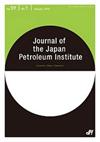利用高密度假丝酵母菌培养基4-6-4T2连续化凝发酵过程中空气喷射对木糖和葡萄糖产乙醇的影响
IF 0.6
4区 工程技术
Q4 ENERGY & FUELS
引用次数: 1
摘要
减少发酵时间和提高乙醇产量对于木质纤维素生物质生产乙醇具有成本效益。增加发酵细胞的密度通常会增加乙醇产量,但也会增加发酵肉汤中溶解二氧化碳(dCO2)的浓度。这种累积的二氧化碳有时会减少乙醇的生产。利用高密度假丝酵母培养基4-6-4T2进行连续化化学发酵(CCF),并以24 h为循环周期,评价其对乙醇产量和快速发酵的影响。将含20 g/L木糖、30 g/L葡萄糖和5 g/L醋酸作为发酵抑制剂的无氮源合成发酵液以15 mL/h的速度补充到培养皿中,以15 mL/h的速度从同一烧瓶中回收发酵液。试验了各种条件来降低发酵肉汤中积累的dCO2,但在CCF工艺中,0.056 vvm的空气喷射对乙醇生产最有效。在24 h分批启动和6循环CCF工艺(144 h)中,乙醇产量为0.4 g/g,使用的中间C. 4-6-4T2在一个周期内的细胞密度是连续分批发酵的三分之一。本文章由计算机程序翻译,如有差异,请以英文原文为准。
Effect of Air Sparging on Ethanol Production from Xylose and Glucose in Continuous Chemostat Fermentation Process Utilizing High Cell Density of Candida intermedia 4-6-4T2
Reducing fermentation periods and increasing ethanol productivity are cost effective for ethanol production from lignocellulosic biomass. Increasing the density of cells for fermentation typically increases ethanol productivity, but also increases the concentration of dissolved carbon dioxide (dCO2) in the fermented broth. Such accumulated dCO2 sometimes reduces ethanol production. The Continuous Chemostat Fermentation (CCF) process utilizing high density of Candida intermedia 4-6-4T2 with and without air sparging was evaluated for the effect on ethanol production and rapid fermentation using 24-h cycles. Synthetic fermentation solution without nitrogen sources containing 20 g/L xylose and 30 g/L glucose plus 5 g/L acetic acid as fermentation inhibitor was supplemented into a culture vessel at 15 mL/h, and fermented broth was recovered from the same flask at 15 mL/h. Various conditions were tested to reduce the accumulated dCO2 in the fermented broth, but air sparging at 0.056 vvm was the most effective for ethanol production in the CCF process. For the 24-h startup-batch and 6-cycle CCF process (144 h), the ethanol yield was 0.4 g/g and the cell density of the used C. intermedia 4-6-4T2 for one cycle was one-third compared to that of sequential batch fermentation.
求助全文
通过发布文献求助,成功后即可免费获取论文全文。
去求助
来源期刊

Journal of The Japan Petroleum Institute
工程技术-工程:石油
CiteScore
1.70
自引率
10.00%
发文量
29
审稿时长
>12 weeks
期刊介绍:
“Journal of the Japan Petroleum Institute”publishes articles on petroleum exploration, petroleum
refining, petrochemicals and relevant subjects (such as natural gas, coal and so on). Papers published in this journal are
also put out as the electronic journal editions on the web.
Topics may range from fundamentals to applications. The latter may deal with a variety of subjects, such as: case studies in the development of oil fields, design and operational data of industrial processes, performances of commercial products and others
 求助内容:
求助内容: 应助结果提醒方式:
应助结果提醒方式:


